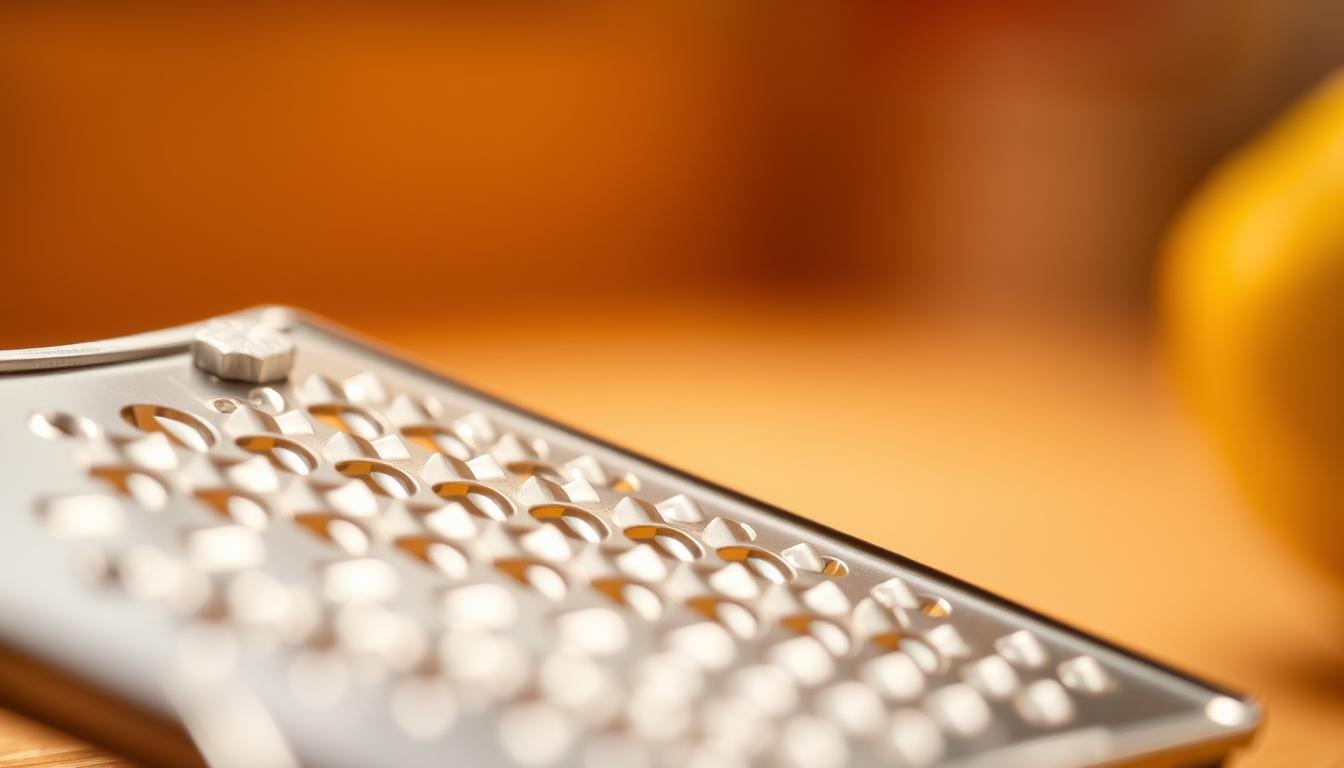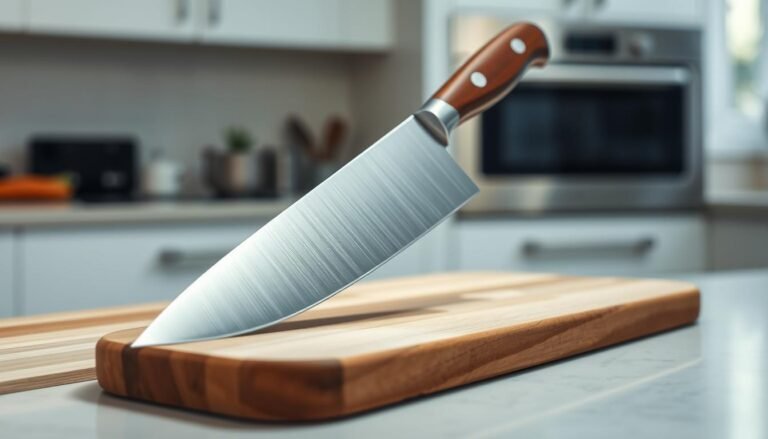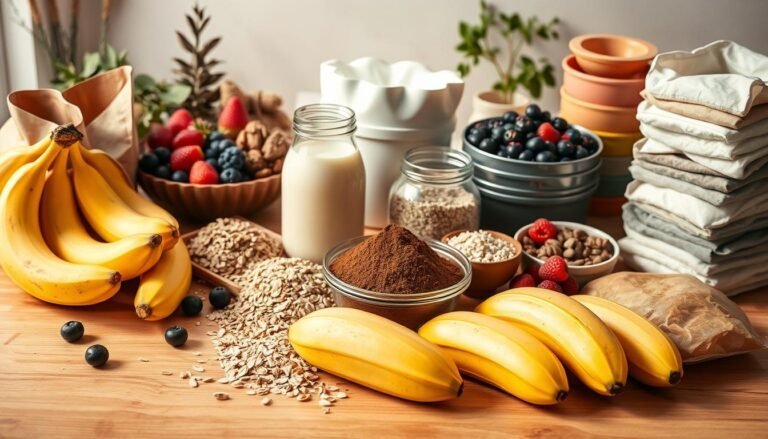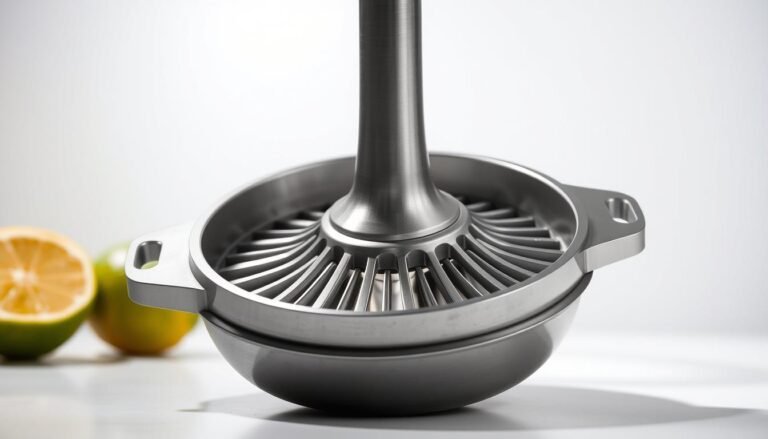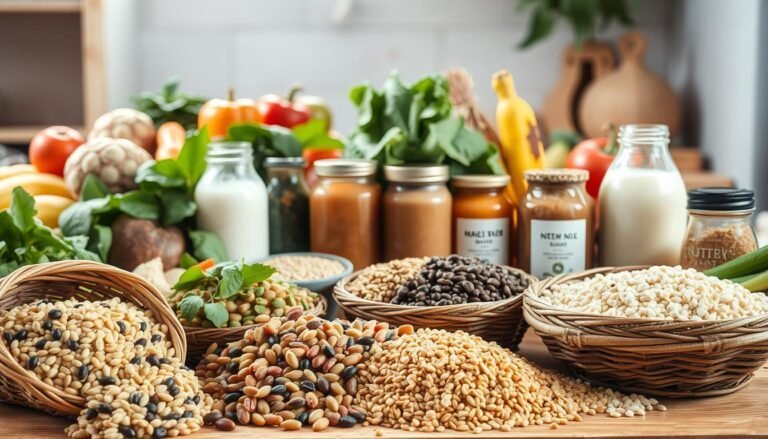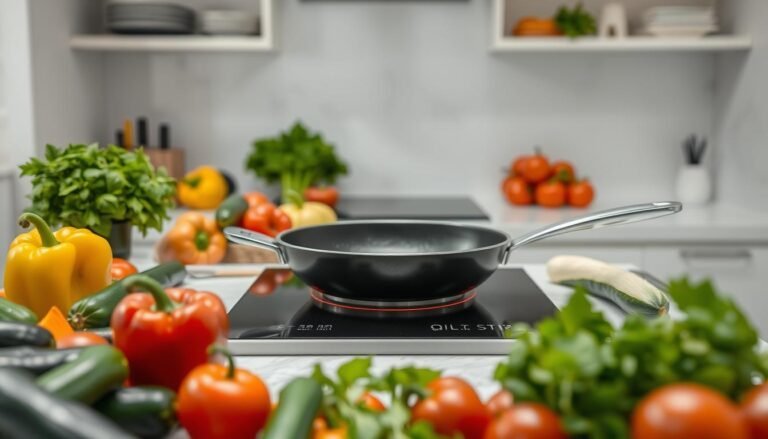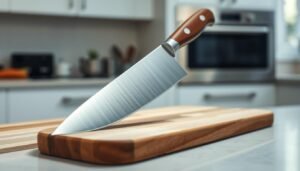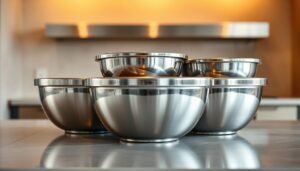Disclosure: This Post Contains Affiliate Links; We earn a commission on purchases.
Unlocking your dishes’ full flavor often depends on your tools. A Microplane or Zester is a kitchen tool that boosts your cooking and baking. It adds fresh, vibrant flavors.
These gadgets grate or zest ingredients like citrus fruits, ginger, or cheese. They release oils and essences into your recipes. Using a Microplane or Zester in your kitchen can improve your dishes’ taste. You won’t need to add extra salt or sugar.
Whether you’re a pro chef or a home cook, knowing how to use these tools matters. It can change your cooking for the better.
Key Takeaways
- Learn how to properly use a Microplane or Zester for maximum flavor.
- Discover the benefits of incorporating these tools into your kitchen routine.
- Explore various ways to zest ingredients for enhanced flavor.
- Understand the importance of freshness in cooking and baking.
- Enhance your dishes with the vibrant flavors of citrus and other ingredients.
Understanding the Power of a Microplane or Zester
A microplane or zester is more than just a simple grater. It’s a key to unlocking flavors. These tools are essential in kitchens for their versatility and precision.
What Makes These Tools Special
Microplanes and zesters have fine blades for precise grating and zesting. This precision makes them stand out from other grating tools. They’re perfect for delicate ingredients.
Different Types and Grind Sizes
Microplanes and zesters come in various types and grind sizes. They cater to different culinary needs. From fine graters for citrus zest to coarse graters for harder cheeses, there’s a tool for every task.
How They Transform Ingredients
Microplanes and zesters turn ingredients into finer particles. This releases flavors and aromas that might be locked away. This is true when zesting citrus fruits or grating Parmesan cheese.
The result is a more complex and enhanced flavor profile in dishes. This makes microplanes and zesters invaluable tools for any chef or home cook.
The Science Behind Flavor Extraction
Unlocking the full flavor of ingredients is all about the science of flavor extraction. Microplaning ingredients releases their flavors and aromas. This is because of several factors.
Essential Oils and Aromatics
Microplaning releases essential oils and aromatics. These are what give ingredients their unique tastes and smells. Cooking utensils like microplanes help release these oils. This makes food taste better.
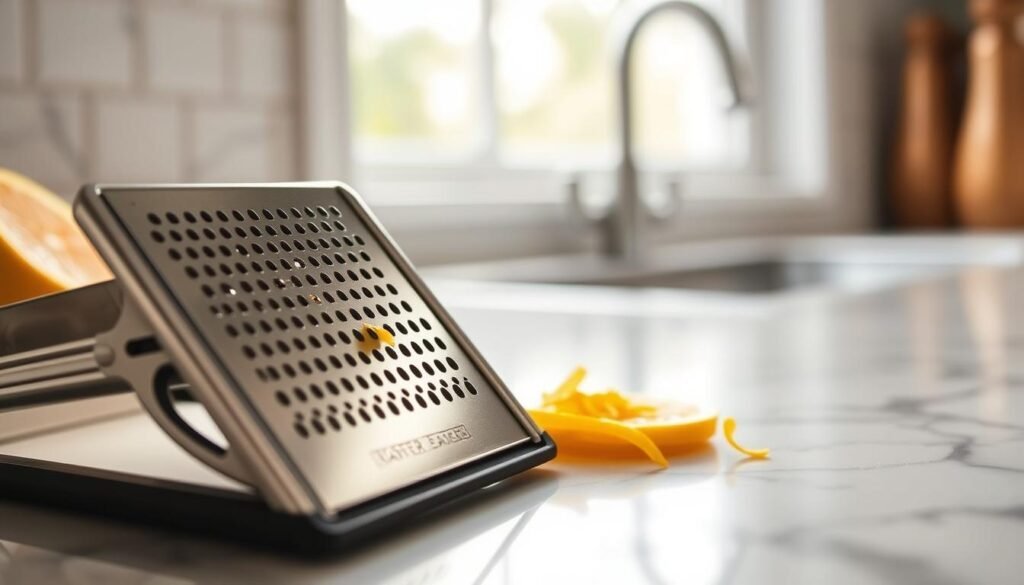
Surface Area and Flavor Release
Microplaning increases the surface area of ingredients. This lets flavors come out more easily. The bigger surface area means more of the ingredient can react with heat and moisture.
Why Microplaned Ingredients Taste Better
Microplaned ingredients taste better because they release more flavors and aromas. Using a kitchen gadget like a microplane adds depth to dishes. It makes flavors more complex.
Choosing the Right Microplane or Zester for Your Needs
Choosing the right microplane or zester can make cooking better. There are many options, so think about a few things to pick the best one.
Fine vs. Coarse Graters
Microplanes and zesters have different grating sizes. A fine grater is great for zesting citrus or grating Parmesan. A coarse grater is better for ginger or nutmeg.
- Fine graters for delicate ingredients like citrus zest
- Coarse graters for harder ingredients like ginger
Handle Designs and Ergonomics
The handle’s design matters a lot. Look for a microplane or zester with an ergonomic handle. It should feel good in your hand, making it easier to use.
Material Quality and Durability
A stainless steel zester or Microplane is a good choice. They last long and don’t rust. Good materials mean your tool will work well and stay safe to use.
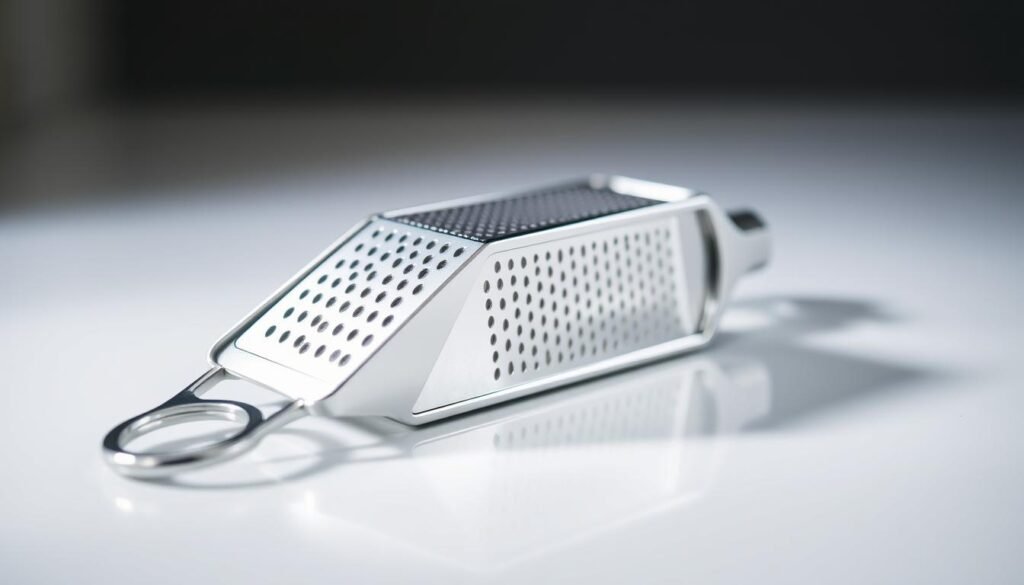
Think about these points to find a microplane or zester that fits your cooking needs. It will make your cooking better.
Essential Foods to Transform with Your Microplane
Discover how your microplane can change many foods. It’s a tool that makes flavors and textures better in many dishes.
Citrus Fruits: Beyond the Peel
Citrus fruits like lemons, oranges, and limes are great for zesting. A microplane captures the peel’s flavor, adding a burst of citrus to your food. For more info, see America’s Test Kitchen on rasp-style graters.
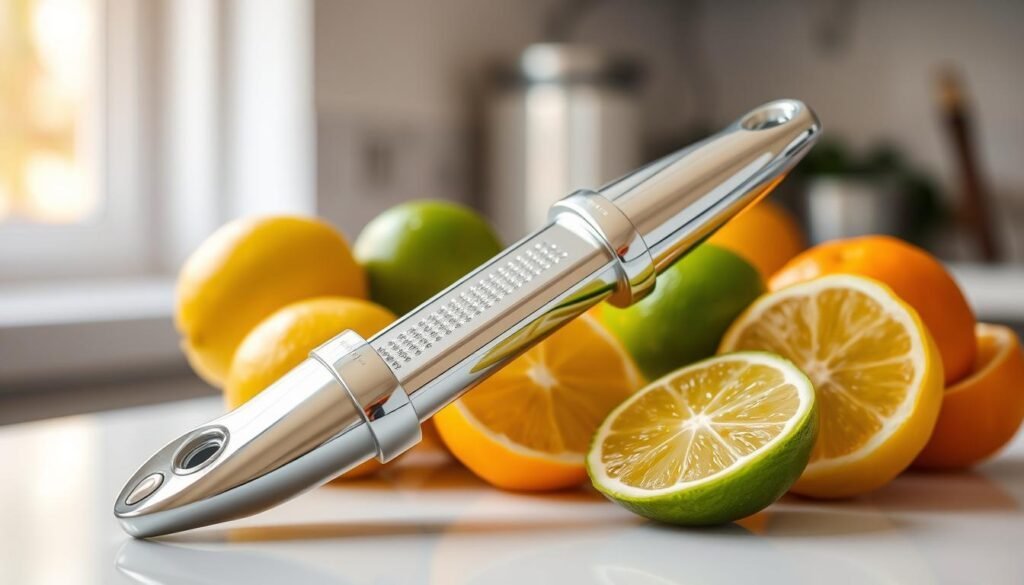
Hard Cheeses: Parmesan, Pecorino, and More
Hard cheeses like Parmesan and Pecorino are perfect for grating. They add rich flavors to pasta, salads, and soups. A microplane grates cheese finely, so it’s spread evenly.
Spices: Nutmeg, Cinnamon, and Ginger
Use a microplane to grate spices like nutmeg, cinnamon, and ginger. It releases their oils and flavors. Freshly grated spices improve baked goods, desserts, and savory dishes.
Chocolate, Garlic, and Other Flavor Boosters
A microplane also grates chocolate, garlic, and more. These add depth and complexity to recipes. Grating them just before use brings out the best flavors and aromas.
Proper Techniques for Using a Microplane or Zester
To get the most out of your microplane or zester, it’s key to know how to use them right. A fine grater, like a microplane, is more than a simple kitchen gadget. It’s a cooking tool that can make your dishes better when used correctly.
Mastering the Grip
First, hold the tool right. Hold the microplane or zester firmly but gently. Find a grip that feels comfortable and lets you control it well.
Directional Movement and Pressure
How you move the tool and the pressure you use are very important. Move it away from you for the best results. Use gentle to moderate pressure, based on the ingredient’s hardness and what you want to achieve.
Safety First
When using sharp tools, safety comes first. Always keep your fingers away from the grating surface.
Using a Guard or Holder
Using a guard or holder can lower the risk of accidents. These tools help keep the ingredient stable and your fingers safe.
Proper Hand Positioning
It’s also important to position your hands right. Keep your non-dominant hand away from the blade. Use it to hold the ingredient you’re grating.
By learning these techniques, you’ll unlock your microplane or zester’s full power. You’ll make your cooking better with fresh, grated ingredients.
Creative Culinary Applications
Unlock the full power of your microplane or zester. A stainless steel zester or microplane can make your kitchen work better. It adds depth and complexity to many dishes.
Elevating Desserts and Baked Goods
Microplaning citrus zest or grating nutmeg can change your baked goods and desserts. The fine texture of microplaned ingredients spreads evenly. This boosts the flavor of your dishes.
- Add grated lemon zest to your lemon bars for an intense citrus flavor.
- Use microplaned nutmeg to add warmth to your pies and cakes.
- Grate chocolate over your desserts for a luxurious finish.
Enhancing Savory Dishes and Pasta
A microplane can grate Parmesan or other hard cheeses. This adds a rich, savory flavor to pasta dishes, salads, or soups.
- Grate Parmesan over your pasta for an authentic Italian flavor.
- Add microplaned garlic to your sauces for a depth of flavor.
- Use a zester to create strips of citrus peel for garnishing savory dishes.
Transforming Cocktails and Beverages
Microplaned citrus zest can garnish cocktails, adding a burst of citrus flavor. You can also use a zester to create twists of citrus peel for your favorite drinks.
- Garnish your cocktails with microplaned citrus zest for added flavor.
- Use a zester to create citrus twists for your beverages.
Quick Garnishes for Visual Appeal
A microplane or zester can make visually appealing garnishes. Grate citrus zest or chocolate shavings over your dishes. This adds a touch of elegance.
By using a microplane or zester, you can improve your dishes’ flavor and look. Try different ingredients and techniques. Discover new ways to make your cooking and baking better.
Common Mistakes to Avoid
Using a microplane or zester right is key. These tools can make your cooking better. But, making mistakes can ruin your dishes.
Zesting Too Deep into the Pith
Zesting citrus fruits wrong can make them bitter. Use a light touch and gentle pressure. Stick to the outer layer of the peel.
Using Dull or Damaged Tools
A dull or damaged tool won’t work well. It might even be dangerous. Check your tools often and replace them when needed.
Improper Storage of Zested Ingredients
Zested ingredients lose flavor and smell if not stored right. Keep them in airtight containers in the fridge.
Neglecting to Clean Properly
Not cleaning your tools well can cause bacteria and residue. Clean them after each use. Dry them to stop rust.
Conclusion
A fine grater, like a microplane or zester, is key in the kitchen. It can make your food taste better. Learning how to use it opens up a world of flavors and smells in your cooking and baking.
Microplanes and zesters are very useful. They can add a burst of citrus to desserts or make savory dishes better with grated cheese or spices. These tools can really change how your food tastes.
Adding a microplane or zester to your kitchen lets you try new recipes and flavors. With practice, you can get better at bringing out the best in your food. Your dishes will be delicious and full of aroma, impressing everyone who tries them.
FAQ
What is the difference between a microplane and a zester?
What type of microplane or zester is best for grating hard cheeses like Parmesan?
How do I clean my microplane or zester?
Can I use a microplane or zester for grating spices like nutmeg or cinnamon?
How do I store zested ingredients to preserve their flavor and aroma?
What are some common mistakes to avoid when using a microplane or zester?
Can a microplane or zester be used for other ingredients like chocolate or ginger?
Are there different types of microplanes or zesters available?

Focused on simplicity and flavor, Ryan helps readers create quick vegan meals and snacks without the overwhelm. Whether you’re new to vegan cooking or just want to keep it simple, Ryan’s tips, guides, and no-fuss approach make plant-based eating accessible and enjoyable for everyone.
Subscribe to Our Newsletter

